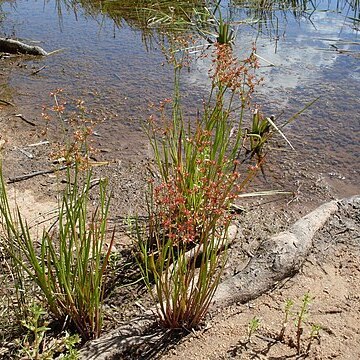Plants perennial, tufted, (8--)10--65 cm tall. Stems erect or ascending, terete or compressed, 0.7--3 mm in diam. Basal leaves few, cauline leaves 2--4; leaf sheath auricles obtuse, short; leaf blade linear, terete to compressed, 10--25 cm × (1--)2--4 mm, distinctly and perfectly to incompletely septate, apex obtuse, acute, or acuminate. Inflorescences terminal, sparingly or much branched; involucral bract leaflike, shorter than inflorescence; heads 5--10(--30), globose to hemispheric, 7--10 mm in diam., (3--)8--15(--20)-flowered; bracts 2--2.5 mm, broadly ovate to ovate-lanceolate, thinly membranous. Perianth segments narrowly lanceolate to linear-lanceolate, 3.5--4 mm, subequal, veins longitudinal, apex acute. Stamens 3, inserted opposite outer perianth segments; filaments 1.2--1.4 mm; anthers 0.9--1 mm. Stigmas very long, often recurved or sinuous. Capsule narrowly prismatic, 3.8--4.5 mm; angles prominent, acute; placentas not or only slightly intruded, hence fruit 1-loculed. Seeds wax yellow, oblong, 0.6--0.8 mm, regularly longitudinally ribbed; transverse veins faint, remote. Fl. (Jan--)Mar--Jun, fr. May--Nov.
Loosely tufted. Stems 9–60 cm. × 2–4 mm., erect, or occ. shortly creeping and rooting at the nodes towards the base, us. compressed, occ. terete. Lvs 8–30 cm. × 2–5 mm., ∞, both basal and cauline, us. < stems, lamina much compressed but hollow, longitudinally multi-tubular, the individual tubes transversely septate, lf-tip us. acute, occ. slightly dilated; sheath broad and loose, with membr. margins and 2 obtuse auricles. Infl. a terminal, much-branched cyme, with globular fascicles of 6–12 fls at the ends of the spreading branchlets; subtending bracts 1–2, lfy, < infl., septate. Fls 3–4 mm. long; tepals acuminate, ± equal or the outer occ. shorter, greenish brown, occ. red, membr. margins very narrow. Stamens 3, c. ½ length of tepals. Capsule 4.5–5 × 1–1.5 mm., us. much > tepals, triquetrous, ovate-lanceolate, gradually narrowed to a mucronate tip, rust-or straw-coloured.
Tufted perennial to 60 cm high. Stems 9-60 cm × 2-4 mm, flattened, lacking internal transverse septa. Leaves compressed, longitudinally multitubular, the individual tubes transversely-septate. Inflorescence 5-22 cm long with long branches and large distant flower-clusters. Stamens 3. Capsule c. 5 mm long, > tepals, triquetrous, long-tapered.


